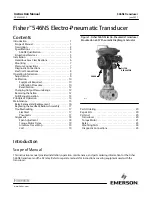
The transmitter must be power supplied with 24Vac/dc.
It is recommended to use a connection cable of at least 0,5mmq
section and a maximum length of 100mt. Connection cables
must have separate run from power cables.
It is recommended to check the maximum load, if used with
current output, or the minimum load, if used with voltage output.
In order to use voltage output (0-10V) pin 7 and 8 must be
connected together.
In order to access the 2 programming buttons, remove the front cover of the transmitter.
Then connect a reference multimeter to the analogue output pins.
1)
Press
P2
button for at least 3 seconds, until
GREEN
led start blinking, and
RED
leds blink alternatively.
2)
Set fluid at the desired level and wait until value on multimeter is stabilized. Then
press and release
P2
for first threshold (
OUT1
) or
P1
for second threshold (
OUT2
).
3)
Repeat step 2) if you need to acquire the other threshold. Please note that now is
blinking the
RED
led corresponding to the threshold that is not acquired yet.
4)
To store threshold(s) acquired press and release both
P1
and
P2
.
Is it possible to disable thresholds on the transmitter by executing only step 1) and 4).
Threshold calibration
4-20mA or 0-10V output calibration
During manufacturing and factory testing, the transmitter is calibrated for 4-20mA or
0-10V output using precise instruments. This calibration should be executed only if a
different output type or range is needed.
In order to access the 2 programming buttons, remove the front cover of the transmitter.
Then connect a reference multimeter to the analogue output pins.
During this calibration phase, relays output will be activated for diagnostic purpose. It is
recommended to disconnect upper terminal board.
1)
While transmitter is powered off, keep pressed both
P1
and
P2
buttons and then
power on.
2)
Keep both buttons pressed for at least 3 seconds, until
GREEN
led start blinking:
now it’s possible to release them.
3)
OUT2 RED
led is now on, indicating the output calibration corresponding to the
minimum level.
4)
Press
P2
for increase and
P1
for decrease the output value, until you read on
multimeter the needed value (ex. 0,0Vdc or 4,0mA).
5)
Now press both
P1
and
P2
and release them.
6)
OUT1 RED
led is now on, indicating the output calibration corresponding to the
maximum level.
7)
Press
P2
for increase and
P1
for decrease the output value, until you read on
multimeter the needed value (ex. 10,0Vdc or 20,0mA).
8)
Now press both
P1
and
P2
and release them.
9)
Both
RED
led remain on for a few seconds while data are stored in the transmitter.
10)
Transmitter reset itself and start working.
0-100% level calibration
In order to access the 2 programming buttons, remove the front cover of the transmitter.
Then connect a reference multimeter to the analogue output pins.
1)
Press
P1
button for at least 3 seconds, until
GREEN
led start blinking, and
RED
leds blink alternatively.
2)
Set fluid level at minimum and wait until value on multimeter is stabilized. Then
press and release
P1
button.
3)
Now only one of the two
RED
leds is blinking. Set fluid level at maximum and wait
until value on multimeter is stabilized. Then press and release
P2
button.
4)
RED
leds are now blinking together. Press both
P1
and
P2
and release them so
that transmitter writes in memory the data acquired.
It is possible to acquire only of the two level settings, by pressing
P1
button for minimum
level or
P2
button for maximum level and then confirm by pressing both
P1
and
P2
.
For better performance, it is recommended to avoid calibration where the difference
between minimum and maximum level is lower than 1/3 of transmitter range span.
Electrical connections
LED signalling
GREEN LED (Power):
•
ON: transmitter is powered and working
•
Fast blinking: programming mode
•
Slow blinking: empty or invalid data in eeprom, transmitter need to be calibrated
(both output and level)
RED LED (Out1 - Out2):
•
ON: active level threshold
•
Blinking: programming mode




















